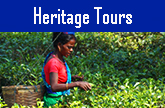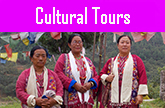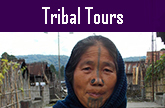Sikkim Tourism
Designated to be the least populous state in India and the second smallest state after Goa, Sikkim is situated in the midst of mighty Eastern Himalayas, surrounded by three foreign nations, Nepal in the west, Bhutan in the south-east, China’s Tibet Autonomous Region in the north and Indian province West Bengal (Dargeeling) on the south. The presence of the world’s third highest peak Kangchenjunga (28209 feet) on Sikkim’s border enriches the majestic scenery and natural landscapes of the state. The numerous passes over mountains, delightful valleys and hill slopes, sparkling rivers & cascading waterfalls, rich variety of flora & fauna, calm monasteries, fascinating meadows enlivens the beauty of the state forming it to be a famous tourist destination of North East India.
Sikkim : At A Glance
State Capital:
Gangtok
Official Language:
English
State Animal:
Red Panda
State Bird:
Blood Pheasant
State Flower:
Noble Orchid
Sex Ratio:
890 females for each 1000 males (Census Report of India, 2011)
Population Density:
86 per square kilometer
Major Plantations:
Tea, Medicinal Plants
Geographical Location:
Longitude 88’E to 89’E & Latitude 27’N to 28’N
Area
Sikkim encompasses an area of 7,096 sq kilometers with 4 districts falling under it.
Population
Sikkim has a population of about 610,577 out of which 323,070 are males and 287,507 are females. (Census Report of India, 2011)
Literacy
The literacy rate in Sikkim is 81.42%. Of that, the male literacy rate is 86.55% while female literacy is 66.39%. (Census Report of India, 2011)
Climate
The southern part of Sikkim possesses sub-tropical type of climate. Tundra climate prevails in the northern part of Sikkim. Snow covers the northern part for four months every year with a minimum temperature falling below 0’ C during the night hours. The peaks on the north western part of Sikkim remain frozen all the year round. The residing areas of Sikkim have a temperate climate with summer temperatures rarely increasing 28’ C and reducing to 0’ C during winter. Sikkim experiences 5 seasons – spring, summer, monsoon, autumn and winter. Average annual temperature of the state ranges around 18’ C. Regular snowfall is a common phenomenon in Sikkim. Due to high altitude, temperature in northern region drops down to -40’ C. Monsoon season is characterized by a heavy downpour creating the danger of landslides. There is a record of 11 days of continuous rain occurring in Sikkim during the monsoon.
Economy
Sikkim has an agrarian based economy. 70% inhabitants of the state are engaged in agriculture, mainly terrace farming and Jhum cultivation. Sikkim is the highest producer of Cardamom in India and possesses the largest cultivated area of Cardamom. The state is first on its way to evolution of agriculture purely on organic farming by a target of 2015. The source of economy in the industrial sector is derived from tanning, brewing, distilling and watch making industries, situated mainly in the towns of Melli and Jorethang on the southern region of the state. Small scale industries like handicrafts and agro-based factories add to the economy of the State. The major initiatives adopted by the Govt. of the state for the grand promotion of Sikkim Tourism in the recent years has positively resulted in booming tourism with an enormous rise of the state revenue to 14 times since the last 20 years. The concept of eco-tourism introduced in the tourism sector has generated employment possibilities among the common people.
History of Sikkim
Earliest history narrates of Sikkim being stayed by Buddhist saint, Guru Rinpoche during the 8th C AD. The religious Guru conveyed the idea of Buddhism in the land and predicted the rule of monarchy that would prevail in Sikkim in the upcoming centuries. Legend speaks of Khye Bumsa, the prince of the Minyak House in Kham of Eastern Tibet, obtaining a heavenly prophecy directing him to move towards the south for pursuit of a better fortune. The clan of Khye Bumsa established the monarch rule in Sikkim. In 1642 AD, Phuntsog Namgyal was throned as the 1st Chogyal or priest-king of Sikkim by the three respected lamas with Yuksom as the capital of the land. In the year 1670 AD, the capital was shifted to Rabdentse from Yuksom with the succession of the throne by the son of Phuntsog Namgyal, namely King Tensung Namgyal. The half sister of Chogyal was debarred from the throne of Sikkim. The Bhutanese took advantage of this family dispute and helped the non-receiver of the throne to attack the land in 1700 AD. The Tibetans drove away these political foes and returned the throne to the Chogyal 10 years later. Sikkim tolerated various invasions by Nepalese in the west and Bhutanese in the east during the years from 1717 AD to 1733 AD resulting in devastation of the capital, Rabdentse. At this crucial situation, China sent help to the authority and maintained normalcy in the land. As a result of Nepal’s continuous defeat, Sikkim was taken rule over by the Chinese Qing Dynasty.
During the British rule in India, Sikkim joined hands with Britain in order to defeat their common foe, Nepal. Sikkim was attacked by Nepal which led to the destruction of a major part of the region. This invasion encouraged the British to attack Nepal resulting in the Gurkha War of 1814 AD. However, a treaty signed between Sikkim and Nepal in 1817 AD restored the captured territory back to the state of Sikkim. The allied relation between the British and Sikkim gradually decreased due to the various taxation policy imposed by the British rulers. Moreover, the British ventured into the Sikkim territory without any permission of the Sikkim Govt. thereby leading to conflicts between them. The British sent an expedition against Sikkim as a result of which Darjeeling district and Morang came under the direct rule of British India in 1853 AD. Gradually, the entire kingdom of Sikkim was annexed under the British supremacy. Even after India attained independence, Sikkim continued to remain as an administrative autonomy with Chogyal as the ruler of the state basing on the treaty signed between India and Sikkim. By 1970 AD, the monarch rule of Sikkim slowly became unpopular to the people and a demand for democratic set up roused among the inhabitants. Keeping in view the formal request of abolishing monarchy with 97% of people support Sikkim finally achieved the status of a full-fledged statehood on 16th May, 1975 becoming the 22nd state of Indian Union.
Culture of Sikkim
People
Sikkim is the center of various ethnic groups with a unique culture, food habits, dress patterns and religions. It is the only state of India possessing an ethnic majority of Nepali community. The nature of the tribes of Sikkim is marked by simplicity and modesty that remains intact to the richness of their glorious culture. Lepchas, Bhutias and Nepalese are the main tribal communities residing in Sikkim. Lepchas are believed to be the first residents dwelling in the region. Lepcha means “Ravine folk”. Initially, they were ardent animists, later converting to Buddhism and Christianity. Agriculture is the mainstay of livelihood of this tribe. The Bhutias are the inhabitants residing mainly in the northern part of Sikkim, possessing a rich Tibetan heritage. This tribe has two sub-groups – Lachenpas and Lachungpas constituting about 10% of the total population of Sikkim. They survive mostly on agriculture. The Napalis are the later tribe entering the land of Sikkim. Yet, this community includes 80% of the total population of the state. They have achieved the status of the most dominant and powerful tribe in the state. The Nepalese are engaged in agriculture, mining, tailoring etc. as their source of livelihood. A major portion of this tribe is also involved in the service sector. In the recent times, the population of Sikkim has achieved other communities residing in the urban areas such as Bengalis, Marwaris, Biharis, Punjabis and South Indians.
Festivals
The rich ethnic culture of Sikkim with its varied traditions, lifestyle and customs prevailing among the numerous communities of Sikkim ensures a wide scope of grand celebration of various festivals in the state. With a majority of Nepalese community residing in this land, main Hindu festivals such as Deepawali, Dussehra, Magh Sankranti, Maha Shivaratri, Ram Nabami etc. are celebrated with great pomp and joy. Buddhist festivals like Saga Dawa, Lhabab Dhuechen, Drupka Teshi, Phang Lhabsol, Losoong, Losar, Bumchu also find a major inclusion in the celebration of festivals in Sikkim. Eid-ul-Fitre and Muharram are also marked by the Sikkimese Muslims of the state.
Sikkim folk dance and music are an integral aspect related to the celebration of festivals in the state. Zo-Ma-Lok, Chu-Faat, Tendong Lo Rum Faat, Kinchum-Chu-Bomsa are the famous folk dances of Lepcha community. The folk dances of the Bhutias comprises of Denzong-Neh-Na, Tashi Shabdo, Singhi Chham, Ta-Shi-Yang-Ku, Yak Chham and Guru-Chinlap. Nepali folk dances include Dohori, Tamang Selo, Maruni, Jeurum Silly, Chutkay, Dhaan Nach, Chyap-Brung dance, Naumati and Lakhey (Mask) dance.


















